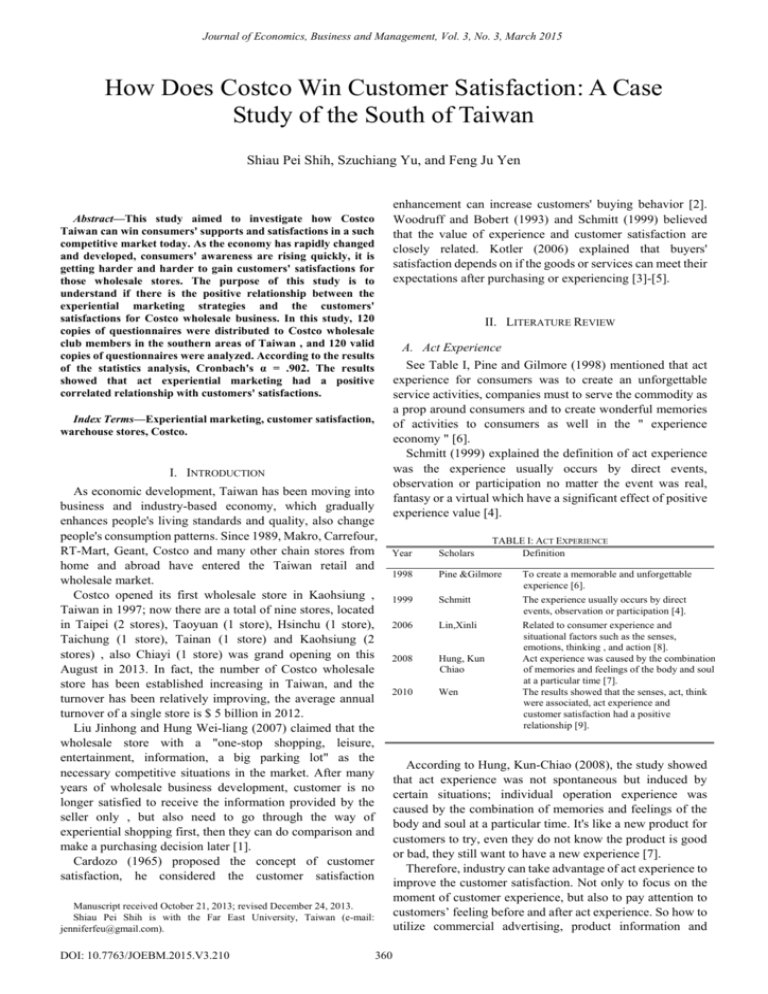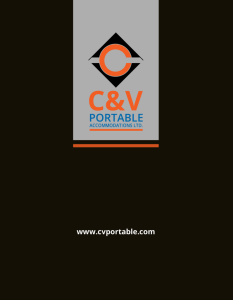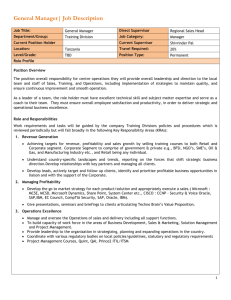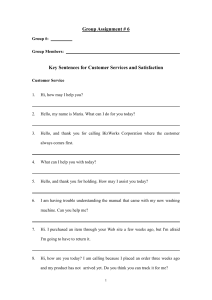
Journal of Economics, Business and Management, Vol. 3, No. 3, March 2015
How Does Costco Win Customer Satisfaction: A Case
Study of the South of Taiwan
Shiau Pei Shih, Szuchiang Yu, and Feng Ju Yen
enhancement can increase customers' buying behavior [2].
Woodruff and Bobert (1993) and Schmitt (1999) believed
that the value of experience and customer satisfaction are
closely related. Kotler (2006) explained that buyers'
satisfaction depends on if the goods or services can meet their
expectations after purchasing or experiencing [3]-[5].
Abstract—This study aimed to investigate how Costco
Taiwan can win consumers' supports and satisfactions in a such
competitive market today. As the economy has rapidly changed
and developed, consumers' awareness are rising quickly, it is
getting harder and harder to gain customers' satisfactions for
those wholesale stores. The purpose of this study is to
understand if there is the positive relationship between the
experiential marketing strategies and the customers'
satisfactions for Costco wholesale business. In this study, 120
copies of questionnaires were distributed to Costco wholesale
club members in the southern areas of Taiwan , and 120 valid
copies of questionnaires were analyzed. According to the results
of the statistics analysis, Cronbach's α = .902. The results
showed that act experiential marketing had a positive
correlated relationship with customers' satisfactions.
II. LITERATURE REVIEW
A. Act Experience
See Table I, Pine and Gilmore (1998) mentioned that act
experience for consumers was to create an unforgettable
service activities, companies must to serve the commodity as
a prop around consumers and to create wonderful memories
of activities to consumers as well in the " experience
economy " [6].
Schmitt (1999) explained the definition of act experience
was the experience usually occurs by direct events,
observation or participation no matter the event was real,
fantasy or a virtual which have a significant effect of positive
experience value [4].
Index Terms—Experiential marketing, customer satisfaction,
warehouse stores, Costco.
I. INTRODUCTION
As economic development, Taiwan has been moving into
business and industry-based economy, which gradually
enhances people's living standards and quality, also change
people's consumption patterns. Since 1989, Makro, Carrefour,
RT-Mart, Geant, Costco and many other chain stores from
home and abroad have entered the Taiwan retail and
wholesale market.
Costco opened its first wholesale store in Kaohsiung ,
Taiwan in 1997; now there are a total of nine stores, located
in Taipei (2 stores), Taoyuan (1 store), Hsinchu (1 store),
Taichung (1 store), Tainan (1 store) and Kaohsiung (2
stores) , also Chiayi (1 store) was grand opening on this
August in 2013. In fact, the number of Costco wholesale
store has been established increasing in Taiwan, and the
turnover has been relatively improving, the average annual
turnover of a single store is $ 5 billion in 2012.
Liu Jinhong and Hung Wei-liang (2007) claimed that the
wholesale store with a "one-stop shopping, leisure,
entertainment, information, a big parking lot" as the
necessary competitive situations in the market. After many
years of wholesale business development, customer is no
longer satisfied to receive the information provided by the
seller only , but also need to go through the way of
experiential shopping first, then they can do comparison and
make a purchasing decision later [1].
Cardozo (1965) proposed the concept of customer
satisfaction, he considered the customer satisfaction
Scholars
1998
Pine &Gilmore
To create a memorable and unforgettable
experience [6].
1999
Schmitt
The experience usually occurs by direct
events, observation or participation [4].
2006
Lin,Xinli
2008
Hung, Kun
Chiao
2010
Wen
Related to consumer experience and
situational factors such as the senses,
emotions, thinking , and action [8].
Act experience was caused by the combination
of memories and feelings of the body and soul
at a particular time [7].
The results showed that the senses, act, think
were associated, act experience and
customer satisfaction had a positive
relationship [9].
Manuscript received October 21, 2013; revised December 24, 2013.
Shiau Pei Shih is with the Far East University, Taiwan (e-mail:
jenniferfeu@gmail.com).
DOI: 10.7763/JOEBM.2015.V3.210
TABLE I: ACT EXPERIENCE
Definition
Year
360
According to Hung, Kun-Chiao (2008), the study showed
that act experience was not spontaneous but induced by
certain situations; individual operation experience was
caused by the combination of memories and feelings of the
body and soul at a particular time. It's like a new product for
customers to try, even they do not know the product is good
or bad, they still want to have a new experience [7].
Therefore, industry can take advantage of act experience to
improve the customer satisfaction. Not only to focus on the
moment of customer experience, but also to pay attention to
customers’ feeling before and after act experience. So how to
utilize commercial advertising, product information and
Journal of Economics, Business and Management, Vol. 3, No. 3, March 2015
promotions to increase customer satisfactions is a key factor
to act experience.
C. Act Experience and Customer Satisfaction
See Table III, Woodruff and Bobert (1993) declared that
the customers’ act experience and customer satisfaction were
closely related [3]. Better experience can bring higher
customer satisfaction. Hong, Hongsheng (2004) [19]
explored that the experiential marketing directly affected
customer satisfaction. The experiential modules of act
experience had a positive relationship with customer
satisfaction. Tsai, Ruiwen (2010) expressed that there was a
positive correlation between act experience and customer
satisfaction [20].
B. Customer Satisfaction
See Table II, Cardozo (1965) proposed the concept of
customer satisfaction, he considered that the raising of
customers' satisfactions can increase their purchasing
behaviors, further it would also affect customer to purchase
other products in store [2]. Fornell (1992) pointed out that
customer satisfaction was created by customers' buying
experience [10].
Chi, Wen Hai (2007) thought customers' satisfaction
coming from the result before or after purchasing or serving,
which meant the better service the higher customers'
satisfaction [11]. Lee, Wen- Ling (2009) believed that
customers' satisfaction was an emotional response by product
expectations, products performance and the quality of
customer services, as in [12].
This study was approved by the literature, and we found
that whether the customer satisfaction good or bad all
depending on if service providers meet their customer
expectations.
III. RESEARCH METHODS
This study was conducted to investigate the relationship
between act experience and customers' satisfactions. The
participants responded to the questionnaire items with the
assurance; hence, data were collected at one point in time, the
response were more truthful than other research methods
such as personal interviews (Babbie, 1990) [21].
A. Research Framework
According to the chapters of introduction and literature
review, we wanted to explore the influence of act experience
on customer satisfaction, so the hypotheses was if there was a
positive relationship between the act experience and
customer satisfaction (See Fig. 1). In this study, the data were
collected from July to September, 2013.
As Schreiber's (2006) rule of thumb is 5 to 10 observations
per item for a test of 12 parameters [22], the sample size for
the present study was set at 120. A total of 120 questionnaires
were distributed and returned. All of these respondents were
in a sample appropriate for further statistical analyses.
Demography, reliability, independent t test and the
correlation analysis were analyzed by SPSS12.0.
TABLE II: CUSTOMER SATISFACTION
Definition
First scholar proposed the concept of customer
satisfaction [2].
Year
1965
Scholar
Cardozo
1980
Oliver
Customer satisfaction was decided by the results
of expectations from product or service [13].
1992
Fornell
Customer satisfaction was created by customers'
buying experience [10].
2002
Wang
Customer satisfaction can be seen as an
identification of customer expectation [14].
2006
Kotler
The performances of goods can meet customers'
expectations [15].
2007
ChiWen Hai
The better service the higher customers'
satisfactions [11].
2009
Yin
The expected cognitive level is consistent before
and after services or goods purchased [16].
2011
Lin Jun
The reflection for overall satisfaction was caused
by the consistent expectations after consuming
[17].
2012
Lin Yongrui
Customer satisfaction was decided by the
customer expectations and what they've actually
gotten [18].
IV. DATA ANALYSIS
A. The Demographic Characteristics
From the Table IV, the percentage of males was 49.0%,
females accounted for 51.0%. It didn’t differ much about
gender in Costco warehouse club stores in the south of
Taiwan. The majority age was under 30 years old (77.5%);
the majority monthly income was less than $ 30,000 (69.2%).
B. Reliability
Scale reliability coefficient refers to the consistency or
stability, reliability is a good indicator in the same operation
was repeated under similar conditions. Nunnally (1978)
suggested that Cronbach's α values is at least greater than
0.70 in the general study [23]. In the present study, the results
were shown in Table V, all of composite reliability scores are
higher than 0.7.
TABLE III: THE ACT EXPERIENCE AND CUSTOMER SATISFACTION
Year
Scholar
Definition
1993
Woodruff &
Bobert
Act experience and satisfaction were closely
linked. The better experience can bring higher
customer satisfaction [3].
2004
Hong,Sheng
Hong
There were a highly positive relationship
between act experience marketing and customer
satisfaction [19].
2009
Yin
2010
Tsai, Ruiwen
Act experience can be positive to customer
satisfaction,. there was a positive correlation.
between experiential marketing and customer
satisfaction [16].
The results showed the act experience and the
customer satisfaction had a positive relationship
[20].
C. Independent Sample T-Test
In Table VI, there was sufficient evidence to show that the
female customers had the stronger feeling of "open hours can
meet my needs" than male in the dimension of "act
experience". Male has more sense than female on the rest of
361
Journal of Economics, Business and Management, Vol. 3, No. 3, March 2015
TABLE VI: T-TEST OF GENDER, ACT EXPERIENCE AND CUSTOMER
SATISFACTION
Dimensions
Questions
Mean
t
P
value
value
Male
Female
N=59
N=61
4.21
1.686
.004*
Act
1. Open hours 4.10
Experience
can meet my
needs
2. Each store
4.34
4.25
2.186
.002*
add. and info.
on the website
3. Providing
4.43
4.16
1.752
.001*
branded
standings
4. Regularly
4.37
3.39
2.439
.002*
product
information
5.
4.35
4.25
1.586
.002*
Membership
cards have
more benefits
Customer
1. Product and 4.31
3.92
2.946
.007*
Satisfaction
service
quality
2. Commodity 4.15
3.72
2.939
.002*
price
items of the dimension of "act experience", especially for
"regular product information". Also, there was a sufficient
evidence to show that the male customers had higher
satisfaction than female in the dimension of "customer
satisfaction".
Fig. 1. Research framework.
TABLE IV: DESCRIPTION ANALYSIS
Range
Number of
Cumulative
people
percentage
Factor
Gender
Age
Income
3. Provider
experience
4.36
3.75
2.984
.451
4. Shopping
space
4.34
4.03
2.980
.001*
5. Clear sales
information
4.27
3.74
4.379
.247
6. Member
coupons
4.07
3.61
4.378
.876
7. Overall
Performance
4.25
3.92
2.368
.926
Male
59
49.00%
Female
61
100.00%
Under 30 years
old
93
77.5%
31-40 years
12
87.5%
41-50 years
9
95.0%
Above 51 years
old
6
100.0%
Less than NT$
30,000
83
69.2
NT$30,001 to
40,000
20
85.8
NT$40,001 to
50,000
8
92.5
Significant
(2-tailed)
NT$50,001 to
60,000
3
95.0
Number
More than NT $
60,001
6
100.0
D. Correlation Analysis
Pearson correlation analysis was used for two other
dimensions: "act experience" and "customer satisfaction", the
result showed coefficients were positive correlation of .506
(see Table VII) and reached significant level (p <0.01), which
indicated that two dimensions were significant correlated to
each other. It explained that the better act experience, the
higher customer satisfaction.
TABLE VII: THE CORRELATION BETWEEN ACT EXPERIENCE AND
CUSTOMER SATISFACTION
Act
Customer
Experience
Satisfaction
Pearson
1
0.506(**)
Act Experience
correlation
Customer
Satisfaction
TABLE V: CREDIBILITY ANALYSIS
Cronbach's Alpha
Number of
Value
Items
0.000
120
120
Pearson
correlation
0.506(**)
1
Significant
(2-tailed)
0.000
Number
120
120
Act Experience
0.902
5
V. CONCLUSIONS AND RECOMMENDATIONS
Customer
Satisfaction
0.901
7
According to statistical analysis results in this study, the
majority customers was females, age under 30 years old and
the average monthly income less than NT$ 30,000. We can
362
Journal of Economics, Business and Management, Vol. 3, No. 3, March 2015
[15] P. Kotler, “New directions in museums, visitor experience, and
marketing,” in Proc. the Museum Marketing Symposium, Taipei, 1998,
pp. 23-43.
[16] C. L. Yin, “The study of the relationship among experiential marketing,
experiential value, customer satisfaction and customer loyalty - A case
study of shangralis leisure farm in Yilan city, Taiwan,” M.S. thesis,
Dept. Bus. Admin., National Chengchi Univ., Yilan, Taiwan, 2009.
[17] P. C. Lin, “The correlation analysis of experiential marketing, customer
satisfaction and loyalty - A case study of consumers' sports goggles in
Taipei area,” M. S. thesis, Dept. Sport and Leisure, National Taiwan
Normal Univ., Taipei, Taiwan, 2011.
[18] Y. R. Lin, “The study of service personnel empathy for business image,
customer satisfaction and repurchase intention- A case study of chain
convenience store,” M.S. thesis, Dept. MIS., Yih Shou Univ.,
Kaohsiung, Taiwan, 2012.
[19] H. S. Hong, “Experiential marketing and relationship marketing on
customer value and customer satisfaction impact of research.
Research,” M.S. thesis, Dept. Bus. Admin., National Kaohsiung Univ.
of Applied Sciences, Kaohsiung, Taiwan, 2004.
[20] J. W. Tsai, “The study of the relationship among experiential marketing,
experiential value and customer satisfaction, customer loyalty – A case
study of Denwell, Taipei,” M.S. thesis, Dept. EMBA, National Cheng
Kung Univ., Tainan, Taiwan, 2010.
[21] E. Babbie, Survey Research Methods, 2nd ed., Belmont, CA:
Wadsworth Publishing Co., 1990, ch. 5, pp. 65-100.
[22] J. B. Schreiber, A. Nora, F. K. Stage, E. A. Barlow, and J. King,
“Reporting structural equation modeling and confirmatory factor
analysis results: A review,” The Journal of Educational Research, vol.
99, no. 6, pp. 323-338, Jul.- Aug. 2006.
[23] J. C. Nunnally, Psychometric Theory, 2nd ed., New York:
McGraw-Hill, ch. 5, pp. 159-205, 1978.
understand there was a significant difference between male
and female on each dimension of act experience and
customer satisfaction. We also can know that the correlation
coefficients between act experience and customer
satisfaction was positive correlated, and the coefficient ratio
was .506 which reached the significant level (p <0.01). From
the result of study, we can tell the female customer
satisfaction was much lower than the male customers. So we
suggest Costco wholesale store should increase the
attractiveness of female commodities for improving female
customers’ act experience for increasing their satisfactions in
the future.
REFERENCES
[1]
[2]
[3]
[4]
[5]
[6]
[7]
[8]
[9]
[10]
[11]
[12]
[13]
[14]
J. H. Liu and W. L. Hung, “The key factors of customer satisfaction in
the wholesale discount stores,” M.S. thesis, Dept. Bus. Admin.
National Chin-Yi Univ. of Tech., Taichung, Taiwan, 2007.
R. N. Cardozo, “Experimental study of customer effort, expectation
and satisfaction,” Journal of Marketing Research, vol. 2, no. 8, pp.
244-249, Aug. 1965.
R. Woodruff and B. Bobert, “Develop and applying consumer
satisfaction knowledge: Implications for future research,” Journal of
Consumer Satisfaction, Dissatisfaction and Complaining Behavior,
vol. 6, pp. 1-11, Aug. 1993.
B. H. Schmitt, Experiential Marketing: How to Get Customer to Sense,
Feel, Think, Act, and Relate to Your Company and Brands, New York,
NY: The Free Press, 1999, ch. 1, pp. 160-161.
P. Kotler and K. L. Keller, Marketing Management, 13th ed., NY:
Pearson Prentice Hall, 2009, ch. 11, pp. 378-414.
B. J. Pine and J. H. Gilmore, “Welcome to the experience economy,”
Harvard Business Review, vol. 76, no. 4, pp. 76-97, Jul.-Aug. 1998.
H. K. Qiao, “Experiential marketing model used in public
transportation empirical study - A case study of Taiwan high speed rail
corporation,” M. S. thesis, Dept. International Business, Hsuan Chuang
University, Hsinchu, Taiwan, 2008.
X. L. Lin, P. Y. Lin, Y. T. Xie, X. Wu, H. C. N. Ya, and P. Z. C. Chien,
“Experiential marketing perspective from theme restaurants consumer
situational factors research, tourism and leisure,” in Proc. of the
Hospitality Industry Sustainability Symposium , Kaohsiung, 2006, pp.
1-8.
W. C. Wen, “The effect of customer testimonial on consumers’ attitude
- The case of beauty product,” M. S. thesis, Dept. of Business
Administration, National Cheng Kung Univ., Tainan, Taiwan, 2010.
C. Fornell, “A national customer satisfaction barometer: The Swedish
experience,” Journal of Marketing, vol. 56, no. 1, pp. 6-21, Jan. 1992.
C. W. Hai, Z. R. Yang, C. S. He, “The news website service quality,
customer satisfaction and loyalty relationship research,” Journal of
Quality Technology, vol. 14, no. 3, pp. 1-15, Sep. 2007.
W. L. Lin, “The network service quality on satisfaction bookstore and
purchase intention - A case study of bookstore network in Taipei,
Taiwan,” M.S. thesis, Dept. Bus. Admin. Tatung Univ., Taichung,
Taiwan, 2008.
R. L. Oliver, “A cognitive model of the antecedents and consequences
of satisfaction decisions,” Journal of Marketing Research, vol. 17, no.
4, pp. 460-469, Nov. 1980.
C. S. Wang, “Interrelationships between brand equity, brand preference
and purchase intention: A study of causes and effects on brand equity,”
M.S. thesis, Dept. of Business Administration, National Cheng Kung
Univ., Tainan, Taiwan, 2002.
Shiau-Pei Shih was born in Kaohsiung city, Taiwan
and her birth date is July 12th, 1968. Ms. Shih has
earned one DBA degree from Northwestern
Polytechnic University, California, USA in 2011
winter. The research field focuses on a cross-cultural
marketing analysis between USA and Taiwan. Dr. Shih
has two different majors of master degrees - one was
MBA degree in project management from NPU,
California, U.S. in 2009 and another was MED degree
in MSCS from AU, Ohio, U.S.in 1995 as well.
Ms. Shih has been teaching in Far East University (FEU) more than 10
years in Taiwan and focusing on the marketing management, strategies and
analysis. She used to be the Chief of Teaching Media Production Section in
Far East University (FEU), Taiwan and a project manager in Sogo Bakery
Co., now she is an assistant professor in Dept. Marketing and Logistics at
FEU.
Dr. Shih is the member of PMI (Project Management Institute). Due to her
abundant working experience, Dr. Shih leads students groups to win several
awards of marketing proposal competition in Taiwan such as Bronze Medal
of San John Award, Champion of 2013 Tic Taiwan Award, and Champion of
2013 Product Innovation and Commercialized Award. Her team has received
many awards recognizing the excellence performance of the work. She also
got twice the best Teaching Awards in FEU.
Szuchiang Yu is an administrative staff at Northwestern Polytechnic
University (NPU), Fremont, California. He received his MSCS degree in
2001 from NPU and served as system administrator afterward. Mr. Yu was
promoted and involved campus operations in daily work and was appointed
as facility manager later. Now Mr. Yu serves as the director of Operations
and IT Affairs in NPU and he is going to earn his MBA degree in spring of
2014 in the near future.
363







